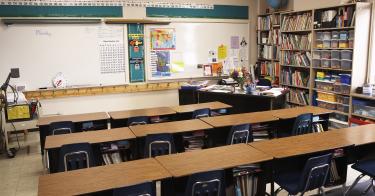The teacher union in Ohio’s largest school district went on strike in early August, keeping children out of classrooms.
The union and district officials settled on a new contract by month’s end, but the terms were hardly favorable to families: Teachers got a raise, while some 50,000 children in Columbus lost a week of school.
After two years of on-again, off-again learning during the pandemic, what a way to start the school year.
According to CNN, “school systems say they are strapped for cash,” despite a $200 billion “bonus” that Washington sent to schools as part of pandemic relief legislation.
>>> Education Freedom Report Card
Schools in Columbus received some $34 million in new cash, the equivalent of the combined salaries of 453 teachers making the district’s average figure of $75,000.
Some parents did not even want their children to attend online classes during the strike.
One parent told a local NBC station that her son “can’t sit in front of a computer all day, that’s not going to be a conducive learning environment for him.”
That’s an understatement. Research finds that students whose schools remained closed to in-person learning longer during the pandemic suffered a greater learning loss than those who returned to classrooms. Scholars and commentators are using words like “devastating” and “failure” to describe the effects of prolonged school closures during the pandemic.
What can state officials do now to help students recover? A new Heritage Foundation study ranks states according to the education options available to families and the state laws that empower parents to decide how and where their children learn. The study examines each state according to its school choice policies, the ease of viewing school curriculum, the level of bureaucracy in state agencies, and the return on taxpayer investment in K-12 school districts.
Ohio ranks 34th in the nation for education freedom overall.
Ohio is at its best in the school choice rankings. It came in seventh in the nation in education options due to its robust K-12 private school voucher and charter school policies. Studies find that offering children additional public and private learning options results in not only higher levels of achievement and school attainment but also greater civic participation and tolerance and lower levels of crime.
Ohio could improve its education choice score by converting its school voucher policy into a K-12 education savings account (ESA) that families could use for a wider variety of education expenses, including tutoring, textbooks, homeschool curricula, online classes and special-needs therapy. Moreover, lawmakers should make the education savings accounts available to all Ohio students, similar to the state’s tax-credit scholarship policy.
Ohio has even more room to improve in the other areas.
For example, the state ranked 35th in terms of making it easy for parents to learn what is going on in the classrooms. COVID-era “Zoom school” gave parents more insight into issues of politicized classrooms and instruction that was uneven and, often, low-quality. Parents have a right to know what their children are being taught. Policymakers could do much more to increase transparency in Ohio’s district school system.
Lawmakers should also make it easier for schools to hire teachers. Unnecessary barriers to entry that have no bearing on instructional quality are keeping qualified teachers out the classroom. These barriers and other red tape are why Ohio ranked 44th for regulatory freedom.
Ohio should create more pathways to becoming a teacher, including expanding alternative teacher certification programs or eliminating teacher certification requirements altogether, and allowing full reciprocity of teacher licensure with other states.
Ohio also ranked poorly 45th in terms of bloated staffing and return on investment. The teacher-to-non-teacher ratio is very low.
>>> Biden Administration “Had a Plan” for School Re-Opening; Let’s Review
This may help to swell union ranks but does little to keep taxpayer resources in classrooms to help prepare students. The bloat in non-instructional staffing, combined with the state’s high pension liability, makes for a low return on investment for taxpayers.
Union antics such as the strike in Columbus are not building goodwill among families—especially after the prolonged school building closures during the pandemic.
Nationwide, some 2 million children have left assigned schools over the last two years. They have either transferred to a private school, opted for homeschooling, or dropped out of school altogether.
Ohio lawmakers should give parents and children more learning options, make coursework more transparent, and reduce the bureaucracy that dictates assigned schools.
Otherwise, thousands of families will be looking at another school year with no options outside of a system that opens only on the say-so of union officials.
This piece originally appeared in The Columbus Dispatch





